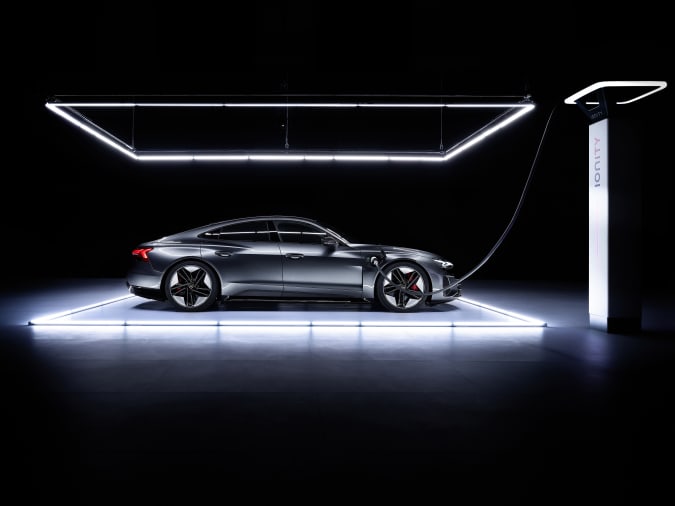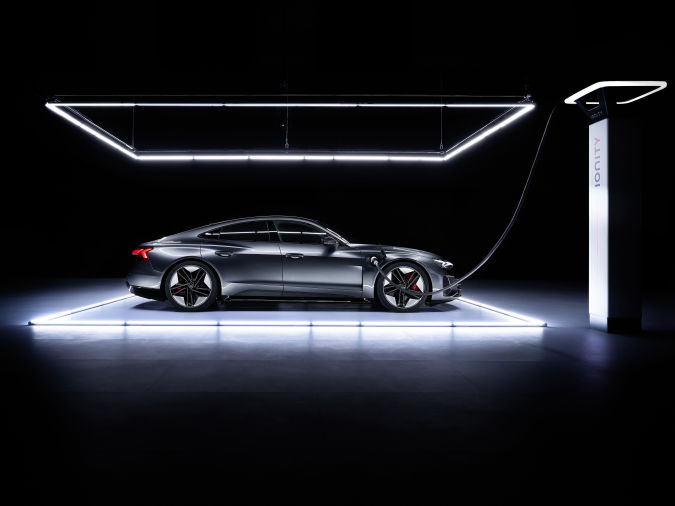It’s been two years since the first fully-electric Audi e-tron made its debut in SUV form. It has since been joined by a Sportback variant and, come later this spring, by a pair of all-wheel drive Grand Touring models — the RS e-tron GT and the e-tron GT quattro. Designed to perform equally well on both daily commutes and weekend road trips, Audi is positioning the RS GT and GT quattro front and center as the future of its fleet electrification efforts which seek 30 percent of its model portfolio to run on electricity by 2025.
The first thing you’ll notice about the new models is that they are very much not SUVs with their large wheels, wide stance, flat silhouette, and long wheelbase. Not to mention that burly podracer-esque growl.
“One of our main design goals was we wanted the sound to be very much dependent on the current driving situation — we want it to be adaptive to the driver’s needs when the car is driving at slow speeds with low torques,” Stephan Herwig with Audi’s marketing department, told reporters during a virtual press conference. “The sound should be more quiet, but of course we’re filling all the legal requirements. But when the driver decides to push the gas pedal then not only will the vehicle be more dynamic but the sound should be more dynamic as well.”
While they can reportedly fit a pair of adults in the backseat without too much knee-scrunching, these are proper sports cars — not just sporty people-movers like their predecessors — and their performance stats reflect that.
The quattro offers 320kW of total power (that’s 175kW from the front motors, 320kW from the single rear and 350 kW under boost), a zero-to-62 of 4.1 seconds and 465 lb-ft of torque. The more capable RS muscles in with 440kW (175kW from the front and 335kW from the rear with a boosted 475 kW total with launch control), a zero-to-62 in just 3.1 seconds, and a 155 mph (governed) top speed.
Both variants are built on the same compact 93.4 kWh battery system, which should be enough to give the quattro and the RS a range of around 298 miles. That’s a bit farther than Tesla’s current-record 265-miles with a battery the same size, but still short enough to potentially stunt the progress of your grand tour. However, since it’s built on the newer 800-volt architecture that we’re starting to see in the market — such as in the Lucid Air and the Hummer EV — hurried drivers will be able to dump around 62 miles-worth of range during a five-minute long “fill up” at rates hitting 270 kW using a DC fast charger. And if you happen to be a regenerative braking master, the GT’s system can recoup up to a reported 265 kW.
The battery itself consists of 396 pouch cells divided into 33 modules (with 12 cells each). Over a standard 11 kW AC line, drivers will be able to fully recharge the GT’s cells overnight, though the company is already working on a 22 kW adapter for release shortly after these models debut. With access to a DC fast-charging station, drivers will be able to refill their energy reserves from 5 percent to 80 percent in around 23 minutes. Some 200,000 of those chargers can be found throughout Europe as part of the e-tron Charging Service program.
The GTs’ impressive range comes in part from the vehicle’s impressive 0.24 drag coefficient, matching that of the Polestar 2. The GT is able to minimize its drag so much thanks to that flat silhouette, an adjustable electronic spoiler and air inlets located in the lower section in the front. These vertical inlets push air from the nose of the vehicle into the wheel wells, cooling the brakes during high impact driving, though they stay closed generally as much as possible in order to improve airflow efficiency as it passes underneath the vehicle. The aerodynamics are further improved with the GT’s active rear spoiler. It’s electrically controlled and can deploy out to two different stages to help negate the lift caused by air flowing under the smooth underbody up from the rear of the car. But despite the vehicle’s aggressive stance, they can each accommodate up to 14.3 cubic feet of luggage in the trunk.

Audi AG
“When you do the analysis of weight versus aerodynamics for battery electric vehicles, you see that actually aerodynamics is quite dominant,” Dr. Moni Islam, Audi AG department of Aerodynamics/Aeroacoustics Development, explained to reporters. “So what we try to do when we design the vehicle in total is to put in as much aerodynamics and drag reducing features as we can, without compromising the driving range and the spoiler is a very good example of that.”
The new variants will be available with both Audi pre sense front and Audi pre sense basic safety systems as standard features. They’ll be joined by a trio of optional “Tour”, “City”, and “Park” packages which offer additional perks like adaptive cruise assist — it figures out how to keep the car moving along with traffic while using the least amount of energy possible — and remote parking, a smartphone-controlled feature you can use from the sidewalk. If you spring for the overarching “Assist” package, you’ll get all three.
Audi is also offering a selection of headlight options to prospective buyers. The quattro will come with LED headlamps standard, though it can be upgraded to Matrix LEDs, which come standard on the RS. Both can be further upgraded to Matrix LED headlights with Audi laser light, which activates when the vehicle accelerates past 43 mph to effectively double the visible range of the high beams. The GT’s will come with 20-inch, 5-spoke rims standard, though the RS can be upgraded to 21s if the buyer prefers. The RS also boasts a five-layer carbon fiber reinforced plastic roof, “a first for an Audi vehicle and a segment-exclusive feature,” according to the company.
Optional in the quattro and standard in the RS, both models offer all-wheel steering. That means the rear wheels can turn up to 2.8 degrees which reduces the vehicle’s turning radius. They’ll turn in the opposite direction as the fronts up to around 30 mph to increase the vehicle’s agility and cornering, but will turn in the same direction as the fronts at speeds above 30 mph to improve stability.
On the interior, the GTs will both offer the 12.3-inch Audi virtual cockpit which replaces the conventional instrument cluster as well as a central 10.1-inch MMI touch display. You’ll have to pay extra for the pop-up HUD. The rest of the cabin is focused on the driver as well with the entire dashboard tilted slightly to the left, giving the driver an unobstructed view of every screen and control. Audi’s Phone Box wireless charging system and a Bang & Olufsen sound system are both additional options as well. Their power plants aren’t the GTs’ only green features. Their entire interiors are leather-free with the seat upholstery coming from recycled materials — Dinamica and Alcantara come standard, though Nappa leather is available. The carpet and floor mats are made from Econyl, a 100-percent recycled nylon, in both models.
While your eyes will likely be glued to the road ahead, the GT will be listening to the electronic world around itself through a series of eleven concealed antennas providing audio, LTE, Bluetooth, and GPS connectivity. Many of the vehicle’s functions can also be controlled via the driver’s myAudi smartphone app.
The e-tron GT will arrive in the US this summer in three trim packages: the e-tron GT quattro Premium Plus for $99,900, the e-tron GT quattro Prestige for $107,000, and the RS e-tron GT for $139,900.
This article is auto-generated by Algorithm Source: www.engadget.com




